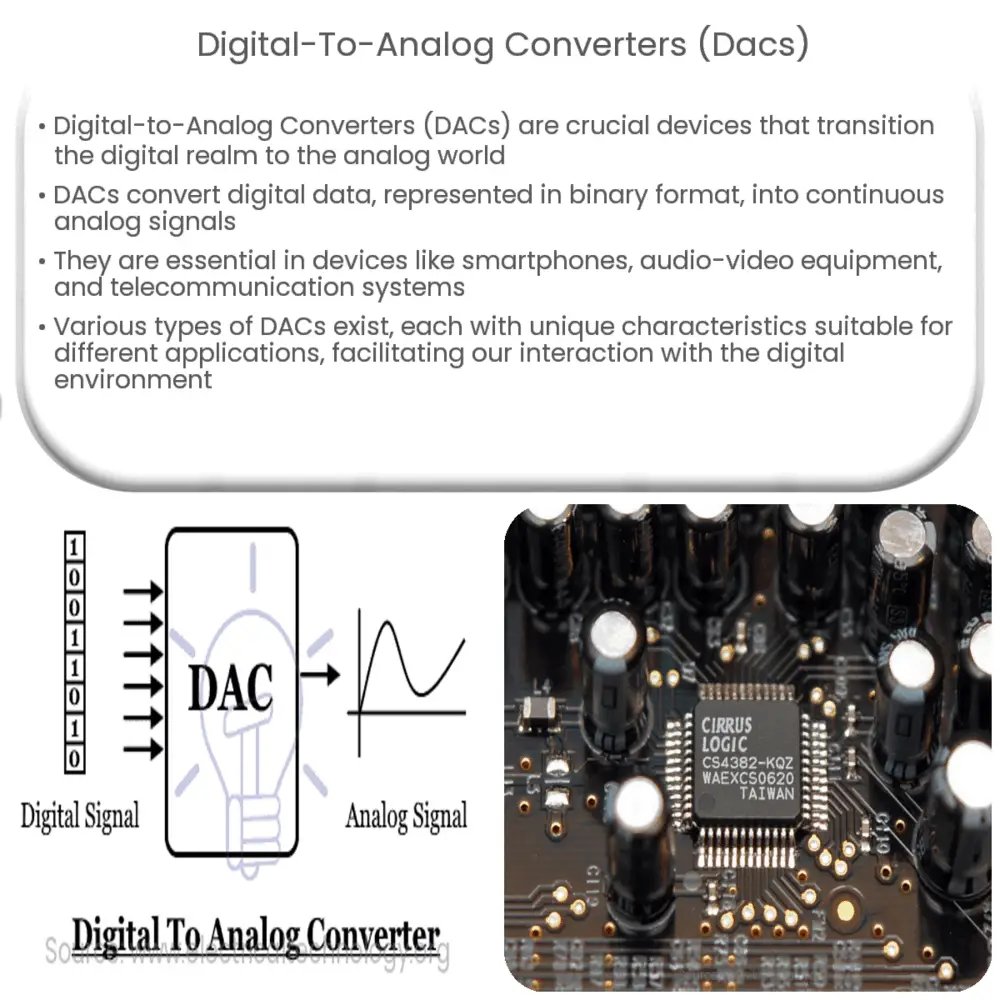Explore the role of Digital-to-Analog Converters (DACs) in bridging digital and physical realms, their types, functions, and applications.

Digital-to-Analog Converters (DACs): An Essential Element in the Digital World
Our daily lives are steeped in the digital world, yet the physical world we interact with is inherently analog. The bridge between these two realities is largely made possible by a pivotal technology: the Digital-to-Analog Converter (DAC).
What are Digital-to-Analog Converters (DACs)?
In the simplest terms, DACs are devices that convert digital data into analog signals. The importance of this process cannot be overstated as it allows digital devices to interact with the real world. In a digital system, data is represented in binary format – a series of ones and zeros. However, most real-world systems work on continuous signals – in other words, analog signals.
Functionality of DACs
DACs play an indispensable role in a plethora of modern devices. They take the discrete digital data and transform it into a continuous physical quantity such as voltage, electric current, or light intensity, enabling digital devices to produce real-world effects. For instance, when you listen to music on your smartphone, the audio file, which is stored in digital format, must be converted into an analog signal that can drive the speaker to produce sound waves.
- Audio and Video Equipment: In audio-video equipment, DACs convert digital stored data into analog signals which can then be amplified and driven through speakers or displayed on a screen.
- Telecommunication: In telecommunication systems, DACs help in modulating digital data into analog signals that can be transmitted over analog media such as coaxial cables or airwaves.
- Microcontrollers and Microprocessors: In these devices, DACs are often used to generate analog output signals for controlling real-world variables like temperature, pressure, or speed.
Types of DACs
There are several types of DACs, each with its unique characteristics and applications. These types primarily differ in the method they use to convert the digital data into an analog signal. Here are a few:
- Binary Weighted DACs: These are the simplest type of DACs which use binary weighted resistors. The downside of these DACs is that they require high precision resistors.
- R-2R Ladder DACs: These DACs only require two levels of resistors, making them easier to manufacture and more commonly used.
- String DACs: Also known as thermometer-coded DACs, these use a series of resistors, each of which corresponds to a bit in the digital input. This design is less prone to errors but tends to be more complex and expensive.
- Delta-Sigma DACs: These DACs employ a technique known as oversampling to provide higher accuracy and are commonly used in audio and high-resolution imaging systems.
The Working Principle of DACs
The working principle of a DAC is relatively straightforward: it receives digital data and converts it into a corresponding analog signal. This conversion involves changing a sequence of discrete, quantized digital bits into a continuous physical signal. To perform this, the DAC uses a reference voltage and a set of switches corresponding to each digital bit. Depending on the digital input, these switches connect or disconnect the reference voltage to a capacitor. This effectively generates an analog voltage that is proportional to the digital input.
Performance Metrics of DACs
The performance of a DAC is characterized by several factors:
- Resolution: This is the number of discrete levels that a DAC can produce. It’s usually expressed in bits. A higher resolution corresponds to a more accurate representation of the analog signal.
- Sampling Rate: This refers to how frequently the DAC can update its output. The sampling rate must be at least twice the maximum frequency of the input signal (as per Nyquist-Shannon sampling theorem) to accurately reproduce the signal.
- Linearity: This indicates how closely the output of the DAC follows a linear function of the input. Non-linearity can cause distortion of the output signal.
Conclusion
In conclusion, Digital-to-Analog Converters (DACs) are instrumental in our digital era, making digital data usable and tangible in our analog world. They are found in a myriad of applications, from audio and video equipment to telecommunications and computer systems. DACs come in various types and configurations, each suited to specific needs and applications. The understanding and continuous improvement of DAC technology is paramount as we continue to bridge the gap between the digital and the physical realm.

